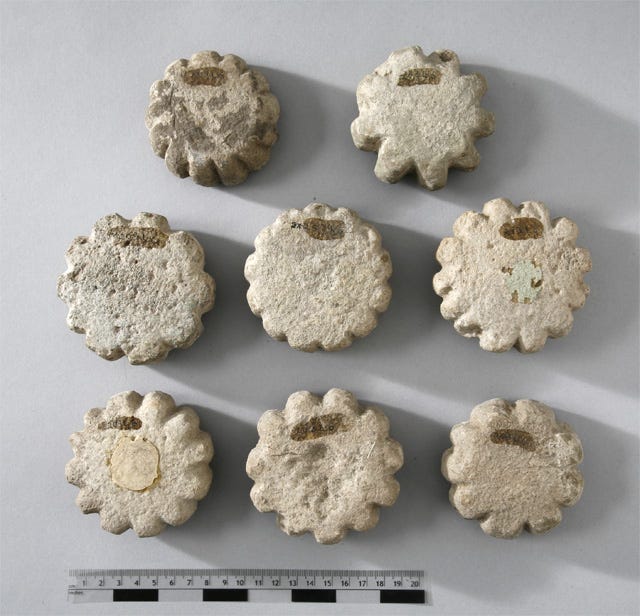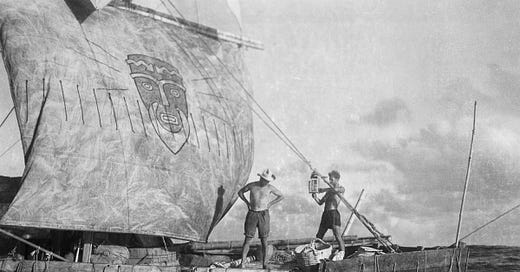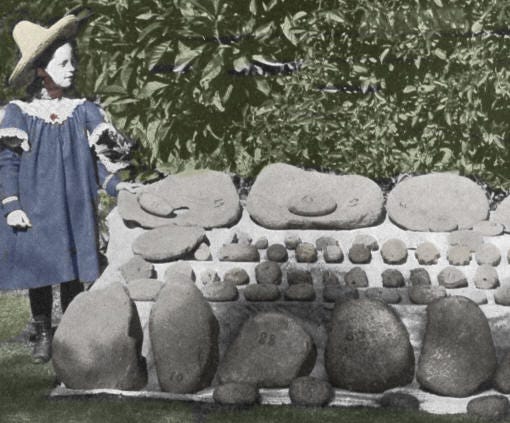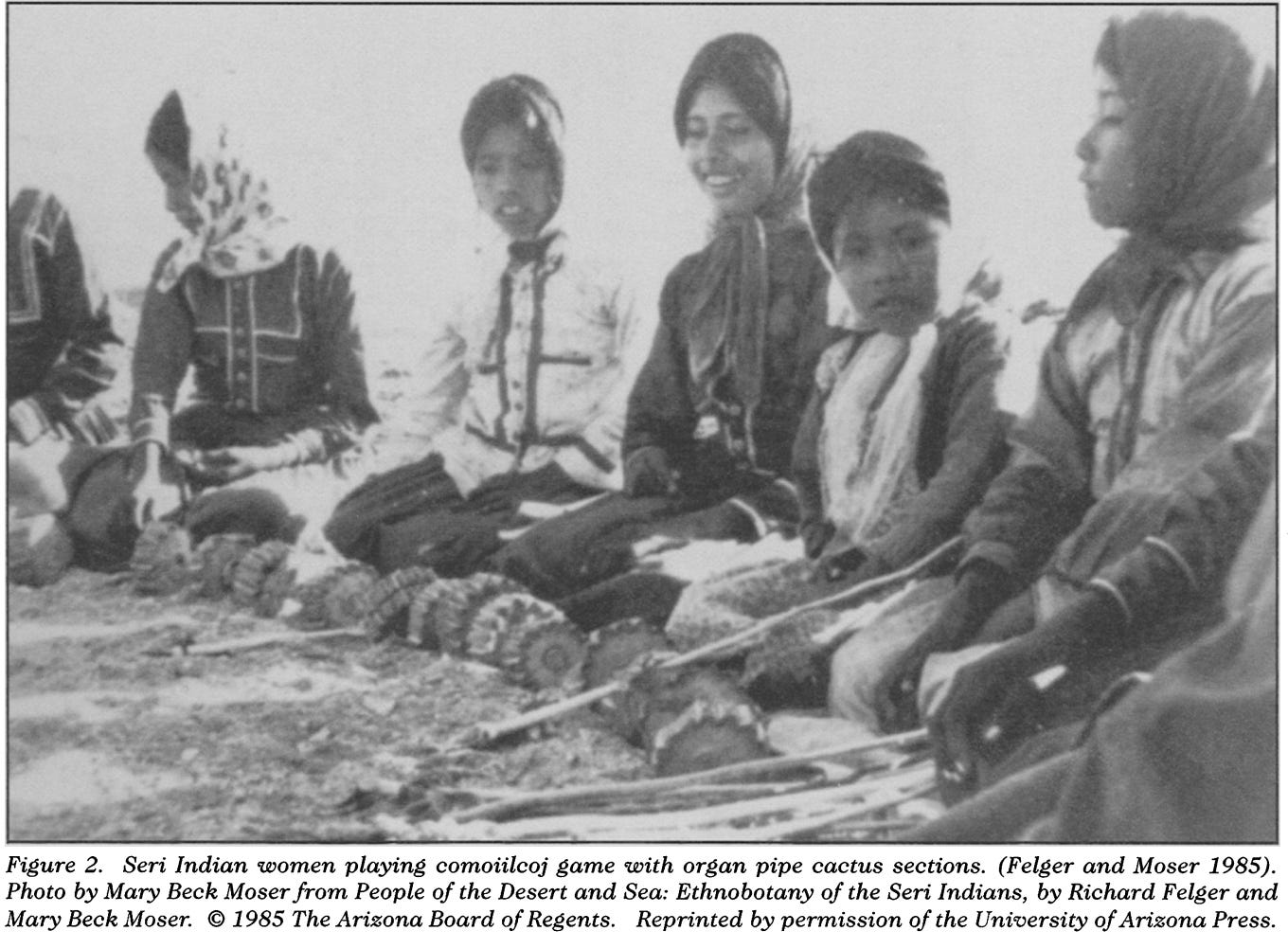Welcome back to my short(er) form post— a log of anthro/archeology topics I’ve found interesting recently. Hopefully you will too! I am trying to make these actually short so they don’t exceed the email limit. (and I failed, once again)…
Entry #1: Thor Heyerdahl and Hyperdiffusionism
In 1947, Norwegian ~explorer~ Thor Heyerdahl gathered funding, public excitement, and team of friends (including a parrot) to sail from South America to Polynesia. This was no ordinary crossing, but a reenactment of a proposed ancient voyage between the two worlds. Heyerdahl himself is difficult to categorize— he was a writer and a biologist interested in zoology, botany, and anthropology, but he was an amateur anthropologist at best. Despite embarking on arduous 5000 mile journey and facing high-seas on a handmade bolsa wood raft, the controversial theory motivating the expedition was never accepted by the academic community.
After 101 days, the Kon-Tiki mission came to a dramatic close on the reef of Raroia. Despite crashing the raft, Heyerdahl and his crew successfully proved that long-distance seafaring was possible from South America to Polynesia with indigenous technologies and knowledge. However, Heyerdahl believed that a race of white-skinned, light or red-haired people were the original colonists of Polynesia.1 Subsequently, he believed Polynesia was colonized from “East” to West, rather than from Austronesians, who must’ve migrated later in time.2 He also thought this mystical white race was also responsible for the civilizations of Middle and South America! Many documentaries and articles on the topic omit this unsavory but extremely relevant issue. Of course, there is no archaeological, historical, or genetic evidence to support Heyerdahl’s theory. It is extremely disappointing that the man who tested long-distance seafaring using indigenous technologies did so to prove that white people must have done it first…
Hayerdahl’s theories are an example of hyperdiffusionism— an untestable and widely discredited theory for explaining cultural change. Hyperdiffusionism is off-shoot of cultural diffusionism, which posits that technology, language, and ideas are transferred from one culture to another via direct, indirect, or forced contact. Hyperdiffusionists took this theory many steps further, believing that technology originates from one culture and is spread directly by people through migration or colonization, without acknowledging mechanisms of communication or trade. The term hyperdiffusionism was first used in the 1960s to derogatorily describe the most fervent and myopic cultural diffusionists. Sir Grafton Elliot Smith was a major proponent of hyperdiffusionism and believed that Egypt was the source of human civilization and that the ancient Egyptians were, of course, a European race! (Originally, he assumed that the origins of civilization must have been in Europe). His theory of a white Heliolithic (sun-worshipping) race inspired Heyerdahl’s expeditions across the Pacific. During the 19th and early 20th centuries, hyperdiffusionism functioned as a theoretical foundation for archaeological racism, a term I am defining thus:
archaeological racism is the attribution of archaeological sites and civilizations to disparate and untenable origins based on racial assumptions and prejudice. 3
Although hyperdiffusionism flourished in the early 20th century, it is the basis of much pseudoscience and pseudo-archaeology today. Beyond attributing Mesoamerican pyramids or Mississippian earthworks to ancient European colonists, this fallacious line of thinking has inspired shows like Ancient Aliens and Ancient Apocalypse. These shows attribute archaeological feats to aliens, Atlantians, and mythical races of giants. I hope that when laid out in this context people can see the racist/colonialist foundations of these theories. A better example of an anthropological seafaring expedition would be Hōkūleʻa, a journey from Hawaii to Tahiti using traditional technology.
After going down a Heyerdahl rabbit-hole, I think I am going to discuss racism and pseudoarchaeology in a future post.
Entry #2: California Cog Stones

Cogged stones, or cog stones, are an enigmatic class of stone artifacts found exclusively in Southern California, mainly in the coastal zone from Ventura to San Diego. They are named after mechanical cogs, but they definitely did not function that way. Since their discovery in the 1950’s archaeologists have proposed numerous theories on their function— almost 40 different theories according to California State Fullerton.
Cog stone sites are typically on coastal bluffs or cliffs near river drainages. They are associated with Millingstone Horizon artifacts— basin metates and manos for grinding grain. Cog stones have also been found in large caches and burial sites, which alludes to their social value and significance. Unlike other ground stone discs, cog stones have between 3 and 22 grooves which resemble suns, squash, or fish vertebrae (some remind me of Chinese mooncakes, imo). Some are perforated with a central hole, though a majority of the stones are unperforated.
Cogged stones are a salient example of how amateur collection can impede archaeological research and interpretations.4 Collectors in the late 19th and early 20th century often overlooked other associated artifacts or did not accurately record site locations. The rapid development of southern California also led to the destruction of archaeological resources. The image below, for example, shows artifacts recovered by Horatio Rust5 during a road grading project in the 1890s. Only a fraction of known cog stones were found in situ, so the full geographic range and contexts of cog stones are unclear. Researchers from California State University, Fullerton have recently reassessed the geology of cog stones and found most of the specimens to be made from locally sourced basaltic scoria (a type of volcanic rock).6 However, there are wide range of material types represented in the known cog stone assemblages including sandstone, limestone, granite, and other volcanic rocks.
Archaeologist look for use-wear to assess the function of a tool— smooth surfaces from grinding, pitting from hammering, or striations from usage. Since cog stones do not have any use-wear (and are an odd shape for a tool) it does not seem like they served a utilitarian function.7 It is also possible that they were used as net or line weights since they are found in coastal areas where net fishing was common. Pigments like red ochre on some stones may suggest they served a ritual function.8 However, cog stones also resemble discoidals used for games in other native cultures.
One of my favorite interpretations is from Dr. Paul Apodaca, a sociologist who specializes in Folkore, Mythology, and American Indian studies. He bases his argument on the game of camoiilcoj played by the Seri of Northern Mexico. Despite reading descriptions of the game over and over, may brain cannot really put together how it works9… BUT! the important thing is that barrel cactus slices are used as boundary markers, and when cacti are not available, players use stones instead. Apodaca suggests that cog stones of SoCal could have been used in a similar way, perhaps for a similar game in a landscape also rich in cactus species. For the Seri people, the barrel cactus is associated with different spiritual, medicinal, and utilitarian functions, and the central perforation of the cactus is sometimes used for holding ritual water and medicine. The article goes on to compare plant species, rock art, and linguistic evidence between the Seri of Mexico and tribes of Southern California like the Tongva and Chumash. Ultimately, Apodaca argues that the “summer squash” type cog stone actually bears resemblance to a cut barrel cactus.
Of course, we have to be careful with transporting ethnographic information from one culture to the archaeological record of another, but Dr. Apodaca addresses these limitations and makes a compelling argument.
Entry #3: The Adena Tablets
The Adena are an archaeological culture from the Late Woodland period in the Mississippi Valley dating from 500 BCE to 100 CE. Ceremonial earthworks, pottery, long-distance trade, and agriculture were hallmarks of the period. The Adena tablets are renowned for their enigmatic iconography with intertwined birds, reptiles, and human faces. However, the engraved visual language of the stone tablets was not easily “deciphered”. A 2015 paper in Anthropology and Aesthetics re-evaluated the tablets and found that some unidentified forms were not so abstract.
Almost all of the Adena tablets were found in burial mounds— great earthworks built over burned funeral structures. Similar to the cog stones, the Adena tablets are only found in a brief range of time and likely served a ritual, but albeit unknown, function. Their deposition, however, does leave some clues. Rather than associated with human remains, most tablets are associated with hearths in the upper layers of burial mounds representing an offering or a burial rite. Undecorated tablets of similar form and material (sandstone, siltstone, limestone) have also been found in burials and may be unfinished engravings. Ochre and pigment residue on the artifacts suggests that they were used as stamps for leather, skin, or even templates for tattoos.
The 2015 paper on the Adena tablets identified new motifs and visual illusions that may represent cosmological beliefs. Tablet rubbings reveal the impression of the objects, but closer inspection using digital imaging clarified some of the more abstract designs. Generally, curvilinear motifs represent animals and mirrored animal heads. The author identified a trend of embedded-head figures, where multiple animals can be seen within the body of another “as if digested”. These composite beings perhaps represent a mystical series or the cycle of creation and renewal. Mirroring is another common visual pun where different species face each other, perhaps representing a symbolic dualism.10
“…the imagery was designed to be seen in stages. The most obvious elements have been arranged to trick observers into believing they have seen the whole picture, hiding foils that can only be perceived when the tablet is reoriented or turned into a negative impression. This strategy of hiding one image within another probably mirrors a layered cosmology or initiatory process that involved phased recognitions.” Caldwell 2015: 108
The tablets were not meant to be understood at first glance, as Caldwell describes in the quote above. They should be held, rotated, and reconsidered. Visual puns and optical illusions reveal embedded figures, dualisms, and layered meanings to the viewer, a language only the Adena can understand. However, Caldwell identified new visual features and species in the tablets which helped in their re-categorization, and helps us get closer to “deciphering” their meaning. He organized tablets based on visual imagery rather than by geographic region or quality of engraving which was how they were previously assessed. Caldwell’s analysis demonstrated the coherent “canon” of Adena iconography, with a shared “grammar” but regional “dialects.” I enjoy the linguistic terminology for understanding these artifacts as visual languages rather than static objects.
“Re-encountering the McKensie Tablet after so many years of false assumptions was a humbling reminder that almost nothing is gratuitous or merely decorative in any imagery derived from complex and impassioned beliefs. This reminds us that we must revisit, rethink, and tease apart almost any prehistoric image before we can begin to fathom its layers of meaning - keeping in mind, of course, that even our most educated guesses may be flawed and that we may never approach full understanding.” Caldwell 2015: 115
When you Google the Adena Tablets, some of the first websites that come up are blogs ruminating on the cultural origins of the artifacts. For instance, this website compares the tablets to Austronesian iconography, theorizing that these artifacts are of exogenous origins rather than local manifestations. These claims are based on the formal features of the artifacts alone, not their context or other archaeological evidence. Since there is no evidence of Polynesian connection between the Eastern United States, this explanation seems highly unlikely (also, how and why would Polynesians go to Ohio, share some art, and leave without a trace?). Furthermore, the double-headed birds and other figures seem like predecessors to later art of the Hopewell period. The overlap of Adena and Hopewell both chronologically and culturally has led archaeologists to reconsider the Adena as an early manifestation of the Hopewell.
This type of superficial analysis reminds me of paleontologists/paleoanths connecting species based on skeletal features. Sometimes species that look similar actually have very different evolutionary lineages. All this to say, just because two things look similar (like Austronesian art and Adena tablets) does not mean they originated from the same source. I did not intent for these three “entries” to fit together, but as I was writing I saw all the threads connect! Some of the Adena interpretations perpetuate hyperdiffusionist rhetoric and there are some hokey theories about cog stones I did not even mention in this article. I appreciate Dr. Apodaca’s analysis of cog stones because it employed multiple levels of evidence and addressed the inherent limitations of this type of research— a good example of cultural comparison without being reductionist or diffusionist, I think!
I keep going back to some of these Caldwell quotes too and how he grapples with our inability to understand ancient art, but our longing to figure it out. O, the archaeological longing…
And despite my best efforts the post is still too long for email. Ugh!
If you’re reading this you should like comment and subscribe <3333
Works Cited:
APODACA, PAUL. 2001. Cactus Stones: Symbolism And Representation In Southern California and Seri Indigenous Folk Art and Artifacts. Journal of California and Great Basin Anthropology. 23: 215-228. 10.2307/27825763.
CALDWELL, DUNCAN. 2014. A New Ordering of Adena Tablets Based on a Deeper Reading of the McKensie Tablet. RES: Anthropology and Aesthetics, 65/66: 105–27. http://www.jstor.org/stable/24871246.
Melander, Victor. 2019. “David’s Weapon of Mass Destruction: The Reception of Thor Heyerdahl’s ‘kon-tiki Theory’”. Bulletin of the History of Archaeology 29 (1): 6. https://doi.org/10.5334/bha-612.
Link to article for more: https://archaeologybulletin.org/articles/10.5334/bha-612
He literally didn’t think Polynesians were capable of seafaring which is crazy because that’s like… their whole thing! They are seafarers! Wow the more I think about the more angry I get…
What do you guys think? Is archaeological racism a thing to define? How should we define it? Let me know your thoughts.
Contextually, data loss and discrepancy is par for the course. American archaeology was in a fledgling state during the late 19th and early 20th centuries so none of this is surprising. I only make this point just to reiterate how important scientific collection and site context are to archaeological interpretations.
I couldn’t find much on this Horatio Rust guy but it seem like he was a regular dude interested in archaeology.
https://news.fullerton.edu/2021/03/geologists-identify-rock-source-of-native-american-cogged-stones-from-orange-county/
Other arguments against them serving a utilitarian function include: use of soft lithic material, investment time vs. return, association with burials, and caching behavior (cog stones kept in large quantities possibly representing caches). (Koerper and Mason 1998: 66)
“ritual function” translates to “we don’t really know but they were probably important??”
I think the description I was reading was also hard to understand, so apologies I can’t paint a better picture here!
Caldwell questions his own species identifications and wondered if our modern understandings of animals translate to the past. Did the Adena peoples categorize animals the same way as us? I find this a fascinating topic to think about!











Por demás interesante!! Se agradece el compartir!!
Thank you for all the effort you put into your posts! I always learn so much 🤓